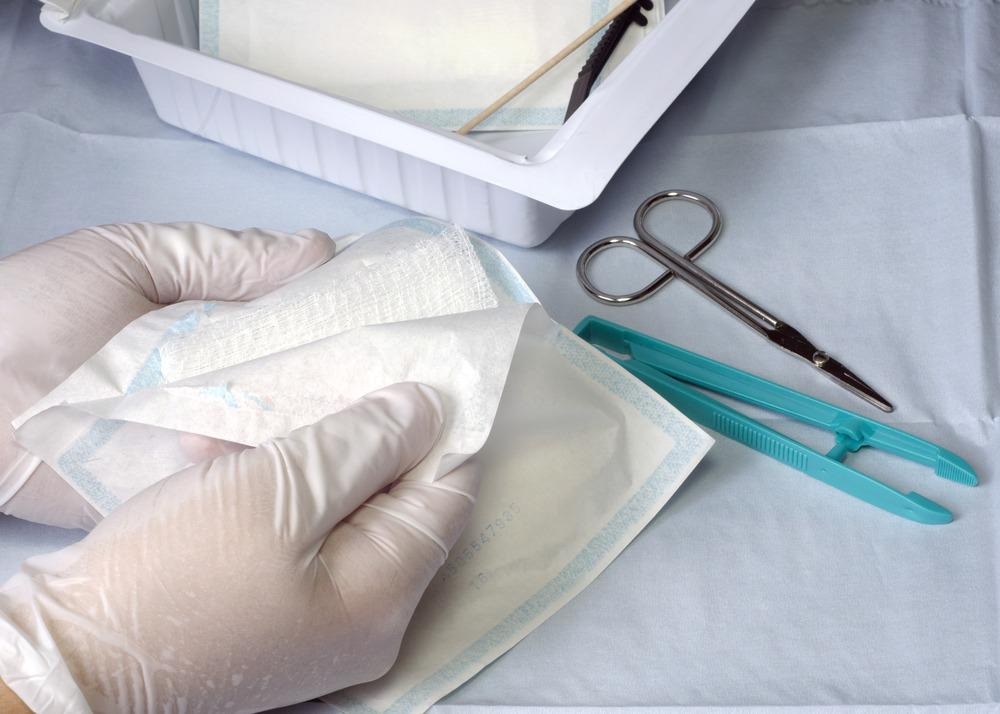With the advancement in nanotechnology, its medical applications have provided a significant difference to the level of diagnosis and therapeutics. The use of nanotechnology for regenerative medicine, including wound healing, is an example of how this industry has advanced and developed novel treatments to provide better care to patients.

Image Credit: MedstockPhotos/Shutterstock.com
Nanofibers can be utilized for this purpose with the added benefit of personalization and precision; nanofibers for skin infections will be discussed further in this article.
Wound healing is a critical area of medicine that requires constant focus and research, gaining traction over the years. With many innovative methods of creating active wound dressings to promote more effective healing, including bacteria-infected skin healing, a group of researchers presented their novel concept of combining nanofibers and unique compounds which contain antibacterial properties.
The Novel Wound Dressing
This innovative development could solve the significant issue of the high volume of bacteria strains that are resistant to common antibiotics, which has led to the requirement of new antibacterial substances to tackle this critical challenge.
The promising novel antibacterial substance, LPPO, has been developed by a research team, including Dominik Rejman of Institute of Organic Chemistry and Biochemistry (IOCB), Prague, in collaboration with Libor Krásný of the Institute of Microbiology of the CAS. Their research was published in the journal Nature. Dominik Rejman explained the significance of LPPO:
Lipophosphonoxins hold considerable promise as a new generation of antibiotics. They don’t have to penetrate the bacteria but instead act on the surface, where they disrupt the bacterial cell membrane. That makes them very efficient at destroying bacteria.
Dominik Rejman, Institute of Organic Chemistry and Biochemistry, Academy of Sciences of the Czech Republic
Benefits Compared to Conventional Treatments
The researchers demonstrated that their novel innovation which consisted of an antibacterial, LPPO, being released from their NANO wound dressing, resulted in antibacterial activity in vitro without affecting or preventing the proliferation and differentiation of fibroblasts and keratinocytes.
Comparatively, current topical antimicrobial agents, which are used to treat a burn or wound infections, negatively impact fibroblasts and keratinocytes; cytotoxic effects on these cells can also affect and reduce wound healing. Additionally, with traditional wound dressings such as gauze, bandages, or cotton wool unable to prevent the drying of wounds and their inefficient requirement of frequent replacements, this can be inconducive to effective wound healing.
An ideally biodegradable, active antibacterial within a dressing that promotes wound healing and prevents skin infections would open new doors for conventional treatments.
To solve this critical problem, the research team used a NANO wound dressing consisting of a polycaprolactone (PCL)-based nanofibrous scaffold created through electrospinning. The significance of this development is the similarity with native extracellular matrix (ECM) and the ability to degrade into metabolite 6-hydroxyhexanoic acid, which can be found naturally.
Other benefits of this nanostructure include its ability to maintain moisture and prevent drying of the wound bed – a critical issue in conventional dressings. The success of the PCL scaffold can be seen in its approval by the American Food and Drug Administration (FDA) for applications including biomedicine and surgical sutures.
The Significance of a Novel Wound Treatment
Using the PCL-based wound dressing, NANO, for medical applications such as wound healing and drug delivery illustrates the potential for the wound healing industry to progress. Through loading the NANO wound dressing with LPPO, a novel approach has been developed to reduce the cross-resistance microbes gain towards antibacterial agents.
During experimental studies that illustrate this antibacterial effect, the research team utilized mouse models to demonstrate how the combination of LPPO and NANO caused a significant reduction in Staphylococcus aureus within infected wounds over seven days post-surgery.
Libor Krásný reinforced the benefits of using LPPO, commenting, “A big advantage of LPPO is the limited ability of bacteria to develop resistance to them. In an experiment lasting several weeks, we failed to find a bacteri[um] resistant to these substances, while resistance to well-known antibiotics developed relatively easily.”
Although skin infections can be resolved quickly and without worry, there remains the risk that chronic wounds can worsen severely. Approximately 19,000 deaths per year are from Staphylococcus aureus infections. Having a novel wound dressing that utilizes nanotechnology and antibacterial agents addresses the critical issue of bacterial resistance, which is very significant for both patient care and the socio-economic burdens that are associated with it.
Promising research can be utilized and innovated with concepts for drug delivery and nanosensors that focus on personalized medicine for increased patient care.
Continue reading: Improving Infectious Diseases Treatment with Nanotechnology: A Review
References and Further Reading
Do Pham, D.D., Jenčová, V., Kaňuchová, M. et al. (2021) Novel lipophosphonoxin-loaded polycaprolactone electrospun nanofiber dressing reduces Staphylococcus aureus induced wound infection in mice. Sci Rep 11, 17688. Available at: https://doi.org/10.1038/s41598-021-96980-7
Eurekalert. (2021) New nanomaterial for treatment of skin infections. [online] Available at: https://www.eurekalert.org/news-releases/929997
HRF. (2021) 26 Important Staph Infection Statistics - HRF. [online] Available at: https://healthresearchfunding.org/26-important-staph-infection-statistics/
Disclaimer: The views expressed here are those of the author expressed in their private capacity and do not necessarily represent the views of AZoM.com Limited T/A AZoNetwork the owner and operator of this website. This disclaimer forms part of the Terms and conditions of use of this website.